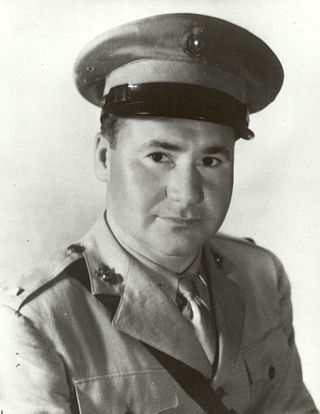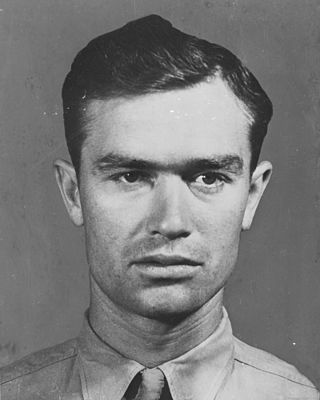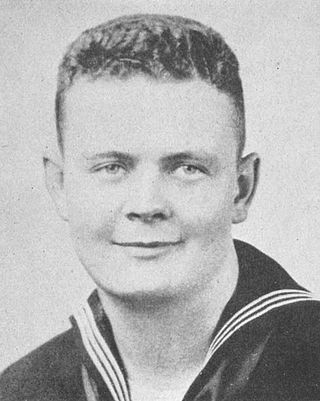
Wesley Lee Fox was a highly decorated United States Marine Corps colonel with 43 years of service. Fox was a combat veteran – receiving the Medal of Honor for his heroic actions during the Vietnam War – and is considered one of the Marine Corps' legendary heroes. After retiring from the Marine Corps, he wrote a book about his career: Marine Rifleman: Forty-Three Years in the Corps; and, he served for 8 years as deputy commandant for the Virginia Tech Corps of Cadets.

William Richard Charette was a United States Navy master chief hospital corpsman who received the nation's highest military decoration for valor, the Medal of Honor. He was awarded the medal for heroic actions "above and beyond the call of duty" on March 27, 1953, while assigned to a Marine Corps rifle company during the Korean War. He retired from the Navy after 26 years of service.

John Paul Bobo was a United States Marine Corps second lieutenant who posthumously received the Medal of Honor for heroism during the Vietnam War on March 30, 1967.

Chief Warrant Officer Harold Edward Wilson was a United States Marine who earned the United States' military highest award, the Medal of Honor, for heroism as a platoon sergeant of a rifle platoon in Korea on the night of April 23–24, 1951 during the Battle of Hwacheon. He received the award from President Harry S. Truman during ceremonies at the White House on April 11, 1952.

David Bernard Champagne was a United States Marine Corps corporal who received the Medal of Honor posthumously for heroism above and beyond the call of duty on May 28, 1952, against Chinese forces in Korea during the Korean War. Champagne was mortally wounded after saving the lives of three Marines from an enemy grenade blast during a hill fight while serving in the 1st Marine Division.

First Lieutenant Harry Linn Martin was a United States Marine Corps officer who posthumously received the Medal of Honor for his actions on Iwo Jima on March 26, 1945.

Captain Carlton Robert Rouh was a United States Marine who received the Medal of Honor for gallantry in risking his life to save the lives of two fellow Marines on Peleliu Island on September 15, 1944. First Lieutenant Rouh threw his body between his fellow Marines and an exploding grenade. During World War II, 27 Marines similarly used their bodies to cover grenades in order to save the lives of others. Four of these Marines survived — including Rouh and fellow Medal of Honor recipients Richard E. Bush, Richard K. Sorenson, and Jacklyn H. Lucas. Rouh had earlier earned a field commission and been awarded the Silver Star medal of gallantry during the Battle of Guadalcanal for action on October 9, 1942.

George Herman O'Brien Jr. was a United States Marine Corps officer who received the Medal of Honor, the United States's highest military decoration, for his actions during the First Battle of the Hook in the Korean War.

Archie Van Winkle was a United States Marine who was awarded the Medal of Honor for his actions as a staff sergeant during the advance to the Chosin Reservoir in the Korean War.

Frank Nicias Mitchell was an American who served in World War II as an enlisted Marine and was killed in action as a Marine first lieutenant during the Korean War while serving with the 1st Marine Division. He posthumously received the United States' highest military decoration for valor, the Medal of Honor, for his actions as a platoon commander during a firefight with the enemy on November 26, 1950, at Hagsang-ni, near Yudamni in North Korea.

Sherrod Emerson Skinner Jr. was a United States Marine Corps officer who sacrificed his life in defense of his outpost and fellow Marines during the First Battle of the Hook in the Korean War. For his actions on October 26, 1952, 1stLt Skinner was posthumously awarded the United States of America's highest military honor – the Medal of Honor.

Jack William Kelso was a United States Marine who posthumously received the Medal of Honor for his actions on the night of October 2, 1952, during the First Battle of the Hook in the Korean War. He was killed while covering the escape of fellow Marines from a besieged bunker. He was the 31st Marine to receive the United States's highest military decoration for valor during the Korean War.

Second Lieutenant Robert Dale Reem was a United States Marine Corps officer who posthumously received the United States' highest military decoration — the Medal of Honor — for his heroic actions during the advance to the Chosin Reservoir in the Korean War; he threw himself on an enemy grenade, sacrificing his life to save his men.

James Irsley Poynter was a United States Marine Corps sergeant who served in World War II and the Korean War where he was killed in action. He was posthumously awarded the United States' highest military decoration for valor — the Medal of Honor — for his actions as a platoon squad leader on November 4, 1950, in which he singlehandedly charged and destroyed three enemy machine gun positions in North Korea at the cost of his life while a member of the 1st Marine Division.

Second Lieutenant George Henry Ramer was a United States Marine Corps officer who posthumously received the Medal of Honor – the United States' highest military decoration for heroism – for his actions in Korea on September 12, 1951, when he sacrificed his life during a fearless attack on an enemy position during the Battle of the Punchbowl. He was the 27th Marine to receive the Medal of Honor for heroism during the Korean War.
Hispanics in the United States Naval Academy account for the largest minority group in the institution. According to the academy, the Class of 2009 includes 271 (22.2%) minority midshipmen. Out of these 271 midshipmen, 115 are of Hispanic heritage. In 2004, of the total of 736 female midshipmen, 74 (10%) of them were of Hispanic descent.

John Harlan Willis was a United States Navy hospital corpsman who was killed in action during World War II while serving with a Marine Corps rifle company. He was posthumously awarded the nation's highest military decoration for valor, the Medal of Honor, for heroic actions "above and beyond the call of duty" on February 28, 1945, during the Battle of Iwo Jima.

George Kenton Sisler was a United States Army intelligence officer and a recipient of the United States military's highest decoration—the Medal of Honor—for his actions in the Vietnam War.
Hispanics in the United States Marine Corps, such as Private France Silva who during the Boxer Rebellion became the first Marine of the thirteen Marines of Latin American descent to be awarded the Medal of Honor, and Private First Class Guy Gabaldon who is credited with capturing over 1,000 enemy soldiers and civilians during World War II, have distinguished themselves in combat. Hispanics have participated as members of the United States Marine Corps in the Boxer Rebellion, World War I, the American intervention in Latin America also known as the Banana Wars, World War II, the Korean War, the Vietnam War, the Gulf War and most recently in the military campaigns of Afghanistan and Iraq.

USNS 1st Lt. Baldomero Lopez (T-AK-3010) / (AK-3010) is the third ship of the 2nd Lt. John P. Bobo-class cargo ship built in 1985. The ship is named after First lieutenant Baldomero López, a US Marine who was awarded the Medal of Honor during the Korean War.




















